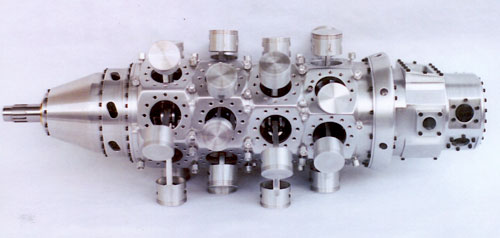Interesting Engines:
The Pratt & Whitney R-4360

I’ll admit it. I’m an engine junkie. Despite not being an engineer by degree or trade, I’m fascinated by the myriad methods pioneers have devised to produce motive power for vehicles. So then, this post will kick off a new series aimed at discussing engines I find particularly interesting.
Let’s go for the gold in the first post: The Pratt & Whitney R-4360 Wasp Major, the largest mass-produced aircraft piston engine ever made. A 28-cylinder, 71-liter, air-cooled radial monster, the ultimate incarnation—the “51VDT”—could deliver a staggering 4,300 hp. Even the first versions of the R-4360 could crank out north of 2,500 hp. Initially “just” supercharged, the final evolution of the Wasp Major incorporated a turbocharger as well.

As illustrated above by a view of the engine’s crankcase, the four rows of seven cylinders were offset radially to allow cooling air to reach the rear rows; even so, there were teething problems getting temps under control in the rearmost cylinders. The mixture powering each piston was ignited by two spark plugs per cylinder, meaning a full 56-plug change was a full-day job for a mechanic. Fuel injection was in its infancy during the R-4360’s gestation, so a pressure carburetor (with a concept similar to single-point injection) metered fuel to the engine.
Applications? The Wasp Major powered some of the largest and most potent aircraft of its time, including six for the Convair B-36 Peacemaker, and four for both the Boeing B-50 Superfortress and Northrop’s pioneering B-35 flying wing. More recently, the R-4360 has found success in pylon-based air racing, the re-engined Hawker Sea Fury Dreadnought clinching gold in the Unlimited class at the Reno Air Races in 1983 and 1986.
Perhaps one of the most amazing aspects of the Wasp Major arises not from the engine itself, but from the turboprops and jet engines that replaced it. Consider, for example, that eight R-4360s were necessary to lift Howard Hughes’ admittedly gargantuan Spruce Goose just 70 feet off the water for a mile. And nowadays, a jetliner of roughly the same size and gross weight like the Boeing 777-300 is accelerated to speeds and altitudes unheard of during the Wasp Major’s heyday with just two General Electric GE90 turbofans. It says a lot for the quantum leap in efficiency and reliability that the 777’s engines are arguably less complex than the R-4360 even as they develop an order of magnitude more power. We’ve made amazing technological progress in the past 60 years, but that doesn’t dampen a bit of the Wasp Major’s fascination.
Editor’s note: This post is part of an ongoing series examining unique and significant powerplants. Read the other installments here:














